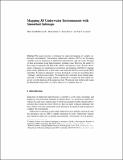| dc.contributor.author | Kaess, Michael | |
| dc.contributor.author | Leonard, John J. | |
| dc.contributor.author | VanMiddlesworth, Mark Allen | |
| dc.contributor.author | Hover, Franz S | |
| dc.date.accessioned | 2019-01-04T20:02:28Z | |
| dc.date.available | 2019-01-04T20:02:28Z | |
| dc.date.issued | 2015 | |
| dc.identifier.isbn | 978-3-319-07487-0 | |
| dc.identifier.isbn | 978-3-319-07488-7 | |
| dc.identifier.issn | 1610-7438 | |
| dc.identifier.issn | 1610-742X | |
| dc.identifier.uri | http://hdl.handle.net/1721.1/119864 | |
| dc.description.abstract | This paper presents a technique for improved mapping of complex underwater environments. Autonomous underwater vehicles (AUVs) are becoming valuable tools for inspection of underwater infrastructure, and can create 3D maps of their environment using high-frequency profiling sonar. However, the quality of these maps is limited by the drift in the vehicle’s navigation system. We have developed a technique for simultaneous localization and mapping (SLAM) by aligning point clouds gathered over a short time scale using the iterative closest point (ICP) algorithm. To improve alignment, we have developed a system for smoothing these “submaps” and removing outliers. We integrate the constraints from submap alignment into a 6-DOF pose graph, which is optimized to estimate the full vehicle trajectory over the duration of the inspection task. We present real-world results using the Bluefin Hovering AUV, as well as analysis of a synthetic data set. Keywords: Point Cloud, Iterative Close Point, Dead Reckoning, Iterative Close Point, Vehicle Trajectory | en_US |
| dc.description.sponsorship | United States. Office of Naval Research (Grant N00014-12-1-0093) | en_US |
| dc.description.sponsorship | United States. Office of Naval Research (Grant N00014-12-10020) | en_US |
| dc.description.sponsorship | United States. Office of Naval Research (Grant N00014-10-1-0936) | en_US |
| dc.description.sponsorship | United States. Office of Naval Research (Grant N00014-13-1-0588) | en_US |
| dc.description.sponsorship | United States. Office of Naval Research (Grant N00014-11-1-0688) | en_US |
| dc.description.sponsorship | National Science Foundation (U.S.). Graduate Research Fellowship Program | en_US |
| dc.description.sponsorship | National Science Foundation (U.S.). (Award IIS-1318392) | en_US |
| dc.publisher | Springer Nature America, Inc | en_US |
| dc.relation.isversionof | http://dx.doi.org/10.1007/978-3-319-07488-7_2 | en_US |
| dc.rights | Creative Commons Attribution-Noncommercial-Share Alike | en_US |
| dc.rights.uri | http://creativecommons.org/licenses/by-nc-sa/4.0/ | en_US |
| dc.source | MIT Web Domain | en_US |
| dc.title | Mapping 3D Underwater Environments with Smoothed Submaps | en_US |
| dc.type | Article | en_US |
| dc.identifier.citation | VanMiddlesworth, Mark, Michael Kaess, Franz Hover, and John J. Leonard. “Mapping 3D Underwater Environments with Smoothed Submaps.” Field and Service Robotics (2015): 17–30. | en_US |
| dc.contributor.department | Massachusetts Institute of Technology. Department of Electrical Engineering and Computer Science | en_US |
| dc.contributor.department | Massachusetts Institute of Technology. Department of Mechanical Engineering | en_US |
| dc.contributor.mitauthor | VanMiddlesworth, Mark Allen | |
| dc.contributor.mitauthor | Hover, Franz S | |
| dc.relation.journal | Field and Service Robotics | en_US |
| dc.eprint.version | Author's final manuscript | en_US |
| dc.type.uri | http://purl.org/eprint/type/ConferencePaper | en_US |
| eprint.status | http://purl.org/eprint/status/NonPeerReviewed | en_US |
| dc.date.updated | 2018-12-12T14:28:18Z | |
| dspace.orderedauthors | VanMiddlesworth, Mark; Kaess, Michael; Hover, Franz; Leonard, John J. | en_US |
| dspace.embargo.terms | N | en_US |
| dc.identifier.orcid | https://orcid.org/0000-0002-2621-7633 | |
| mit.license | OPEN_ACCESS_POLICY | en_US |
